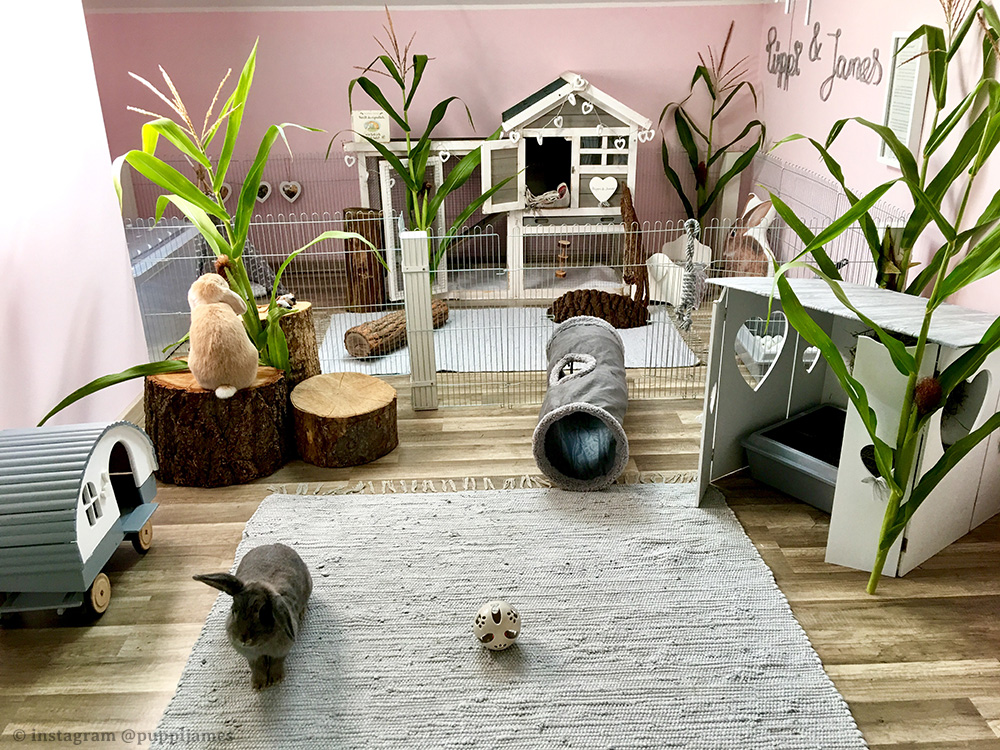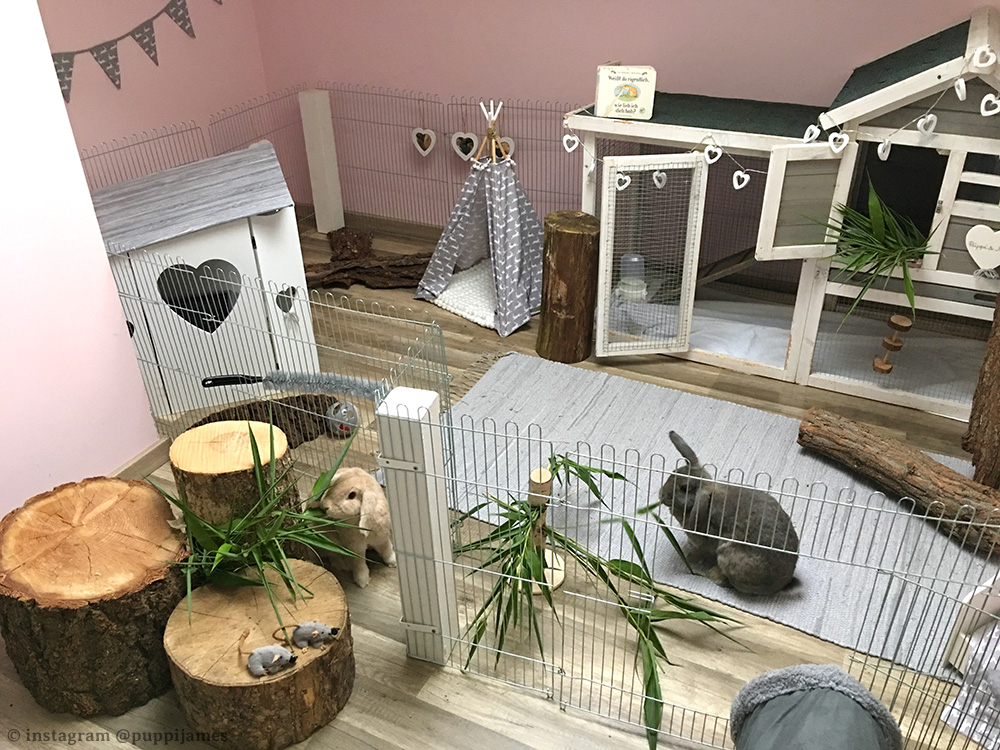Indoor Housing

Even if you don’t have a garden or a balcony you can give your rabbits a nice home in your house.
How much space?
• Two rabbits need at least 6m²
• Each additional rabbit needs +2m²
Two rabbits require at least 4m² of ground area plus a safe area outside of the enclosure to use. If they are unable to have an additional run, then they require at least 6m². For each additional bunny, you require an additional 2m². You can make an enclosure, or dedicate a room or your entire house, as long as it is made rabbit-safe.
Danger Sources
• Hide or remove cords, power sockets, poison plants
For all variations of indoor keeping, including all areas the rabbits are able to go, you need to make them rabbit-safe. That means you must hide cords, power sockets, poisonous plants (put them away or remove them completely). Even if the poisonous plants are on the windowsill, you have to ensure that no parts of the plant will fall to the ground where you rabbit could eat it. Rabbits can be real climbing artists, therefore windowsills, shelves, dressers or similar furniture items can be climbed. Observe your animals carefully at the beginning so that you can investigate the dangers and nullify them.
Commercial Housing
• Only use bottom part of commercial housing – suitable for toilet or hay feeding place
• Houses, tunnels and other places to hide require at least 2 exit points
If you have commercial housing in the areas that your rabbits will be living, you must remove the metal grating from the top, leaving only the bottom of the house. You must do this because rabbits will jump on top of the housing, and will get their legs stuck in the metal grating if it is left on, causing injury. A blanket resting on top of the enclosure will not prevent this. Their legs will still get stuck and injured. The bottom piece of these enclosures is perfect as a rabbit toilet or hay feeding place. Houses, tunnels or other places to hide have to have at least 2 exit points, so that the rabbit always has the ability to flee.

The Ground
• Flooring: Rugs made from natural fibers, PVC, linoleum ← Slip proof and secure so cannot be eaten
Rabbits like to run around and jump when they are happy, therefore the ground needs to be slip-proof. If you have house trained rabbits you can lay down rugs. If urine is sometimes found next to the toilets though, you can lay a PVC or linoleum flooring. With all flooring, regardless of whether it is a rug, PVC or linoleum, you must ensure that it cannot be eaten as it can be very poisonous. If you have tiles or laminate, and your rabbits are unable to walk easily on it without slipping, you can lay rugs (made from natural fibers). Fake grasses and turfs are very bad for rabbits as they cause burns and wounds to the fore legs and hind legs. As rabbits walk or run over these surfaces, friction builds and heat accumulates as well as fur being torn from the bottom of the feet. This leads to injured and sore wounds that can take a very long time to heal.
Free Indoor Keeping
• Rabbit can move freely around the house
• Must have hiding places
• Decorated rabbit-friendly
• Rabbits may chew wallpaper & furniture – however can be prevented
Lots of rabbits become house trained. In this case especially, the option of free indoor keeping is suitable. You can therefore offer them the greatest level of freedom. You must ensure that there is always an area available in apartment or house, where the rabbits can retreat to should they feel the need. The house must therefore be decorated very rabbit friendly (read more here).
With this style of keeping, one must be aware that rabbits may chew on the wallpaper or other furniture. This may only occur occasionally. For some animals, even with an abundance of toys and rabbit furniture, they may still choose to chew the wallpaper or other furniture. There are easy and cheap ways to secure and protect the wallpaper such as wooden panels and fences. Most rabbits are well behaved and can be allowed to jump and run freely around the flat.
 Rabbit Room
Rabbit Room
• Alternative to an enclosure – dedicated whole room
• At least one window
• Ensure lots of hiding places and rabbit safe
As a good alternative to a 24 hour run throughout the entire house or apartment is to offer a Rabbit Room. Here you must ensure that the room has at least one window. You can decorate the room individually for your animals. Some rabbits love to climb, therefore higher platforms at the wall (must be secured so as to prevent the rabbits from falling) are suitable. For fearful rabbits, you must ensure there are lots of hiding places, such as houses, tunnels and wicker bridges. Digging boxes and hiding places in hay, as well as several toilets should also be inside the room.
Inside Enclosure
• Option if limited space
• Very easy and can be built yourself
• Must be at least 80cms high – may be higher depending on the rabbit
• Requires several hiding places and toilets
• Decoration similar to Rabbit Room
Often there is not enough space to offer the rabbits a complete room for themselves. Alternatively you can build them a room enclosure, to give them a part of a room. This is a very easy method to build yourself. You just need a little bit of wire, some wood and some tools. Or you can purchase metal fencing & cage elements. Unfortunately you can only purchase a set containing four or six elements, but to give your rabbits enough space, you must combine more of these sets. The elements must be at least 80cms high, so as to prevent rabbits from jumping over. If this height is enough, you must decide yourself, as some rabbits can jump over 120cms. The decoration is similar to the Rabbit Room, you need as well several hiding places and toilets. Also you may offer several places to sit as rabbits enjoy sitting on raised surfaces, such as on top of tunnels, wooden boxes or any place that allows them to observe the surrounding area. Ensure that these items are not so close to the enclosure wall so as to allow the rabbit to jump over.
Inside Keeping in Summer
• Room temperature can become dangerously hot – must provide cooling options
• Never leave windows open unsupervised due to predators
In apartments or flats, located on the highest floor, the room temperature can become very hot in summer and become very difficult for animals. In this case you must offer cooling, in the same way as the outdoor keeping. It is very important to open the windows regularly, to provide fresh air. However, you must be careful and never leave the window open when you are not supervising, because predators are attracted by smell. This also applies at night, where you may only leave the window open if you are in the same room.
Inside Keeping in Winter
• Ensure minimal temperature difference between rooms
In Winter you must ensure that the temperature difference between the used rooms is not too great. Rabbits who live in heated rooms do not build up a thick winter fur and would freeze and develop colds in unheated rooms. Changing from an unheated room to a heated room is also not suitable for the health of rabbits.
Back to Housing
